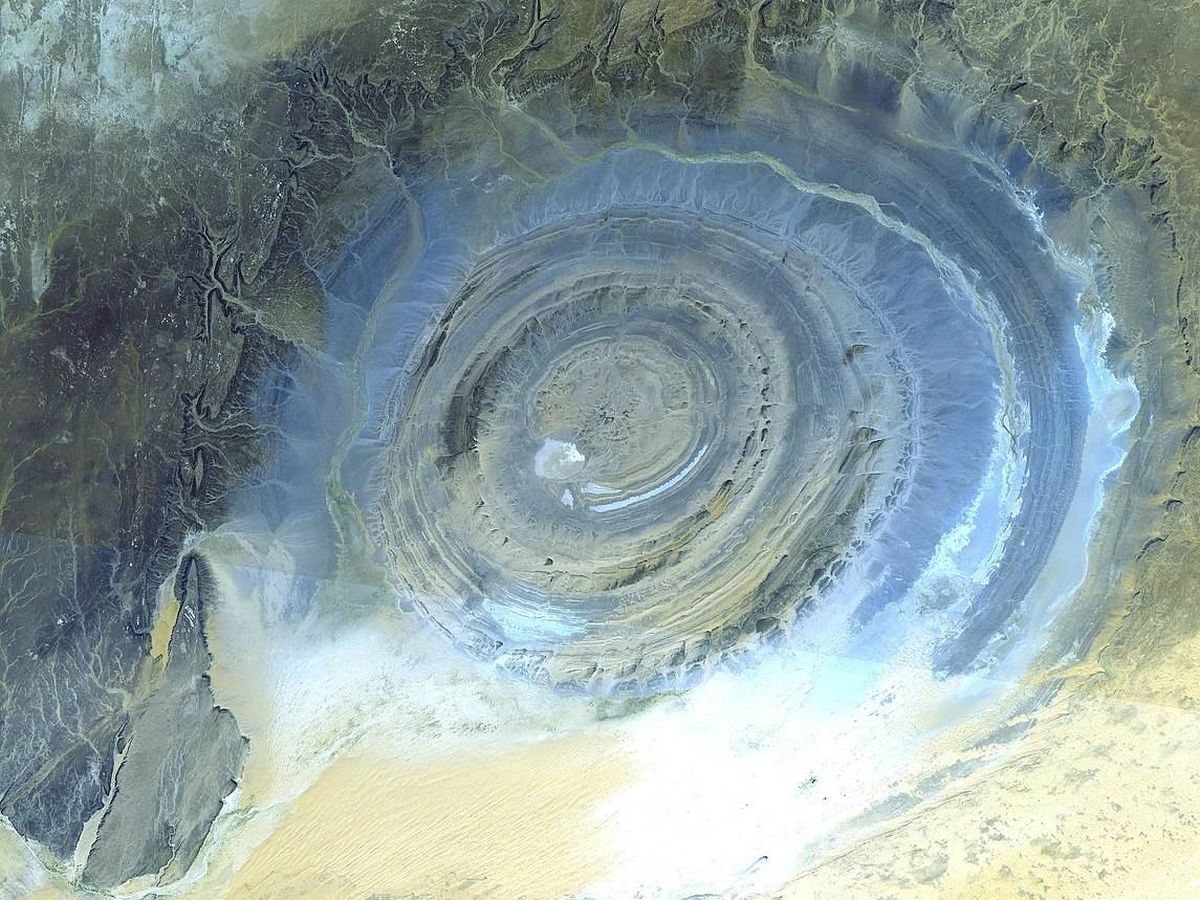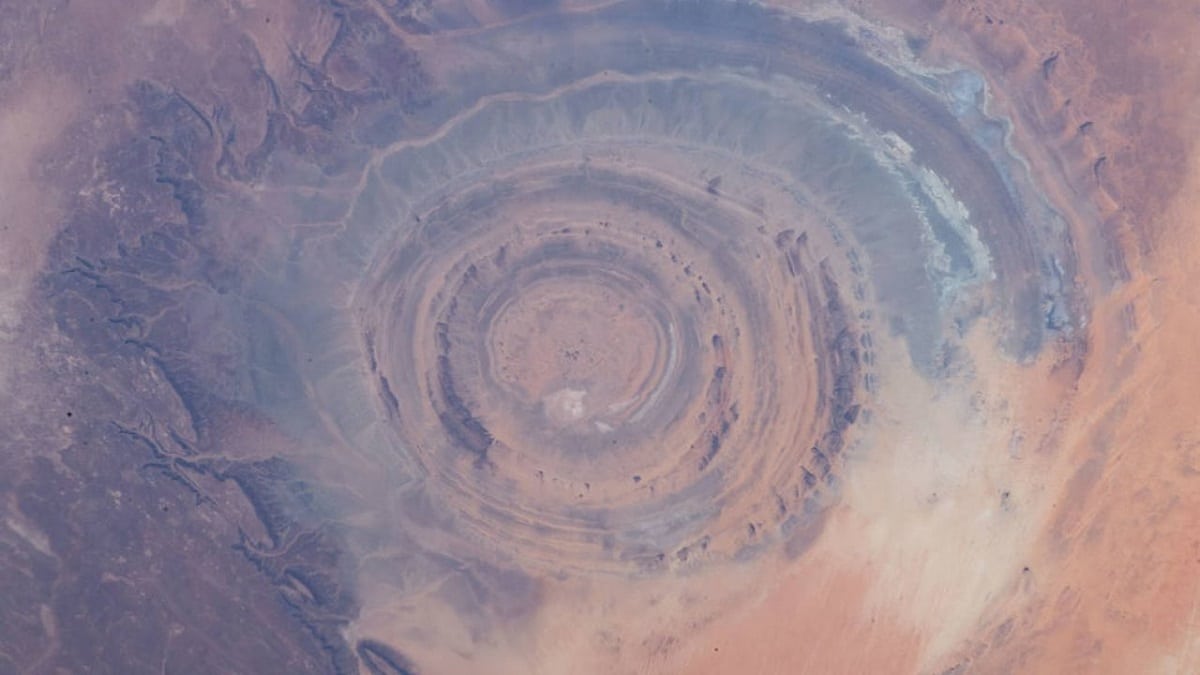
We know that our planet is full of curiosities and places that are beyond fiction. One of the places that draws much attention to scientists is the sahara desert eye. It is an area in the center of the desert that can be seen from space in the shape of an eye.
In this article we are going to tell you everything that is known about the eye of the Sahara desert, its origin and characteristics.
The eye of the Sahara desert

Known worldwide as the "Eye of the Sahara" or "The Eye of the Bull", the Richat structure is a curious geographical feature found in the Sahara desert near the city of Udane, Mauritania, Africa. To clarify, the shape of the "eye" can only be fully appreciated from space.
The 50-kilometer-diameter structure, made of spiral-shaped lines, was discovered in the summer of 1965 by NASA astronauts James McDivit and Edward White during a space mission called Gemini 4.
The origin of the Eye of the Sahara is uncertain. The first hypothesis suggested that it was due to the impact of a meteorite, which would explain its circular shape. However, recent research suggests that it may be a symmetrical structure of an anticlinal dome formed by erosion over millions of years.
The Eye of the Sahara is unique in the world because it is in the middle of the desert with nothing around it.In the center of the eye are Proterozoic rocks (from 2.500 billion to 542 million years ago). On the outside of the structure, the rocks date to the Ordovician period (beginning about 485 million years ago and ending about 444 million years ago).
The youngest formations are in the farthest radius, while the oldest formations are in the center of the dome. Throughout the region there are several types of rocks such as volcanic rhyolite, igneous rock, carbonatite and kimberlite.
Origin of the eye from the Sahara desert

The Eye of the Sahara looks directly into space. It has a diameter of about 50.000 meters and geographers and astronomers agree that it is a "strange" geological formation. Some scientists believe that it was formed after the collision of a giant asteroid. However, others believe that it has something to do with the erosion of the dome by the wind.
Located in the northwest of Mauritania, at the western end of Africa, what is truly incredible is that it has concentric circles inside. So far, this is what is known about the crustal anomalies.
The circumference of the Eye of the Sahara is rumored to mark the trace of an ancient lost city. Others, faithful to the conspiracy theory, affirm that it is part of a giant extraterrestrial structure. In the absence of hard evidence, all these hypotheses are relegated to the realm of pseudoscientific speculation.
In fact, the official name of this landform is "Richat Structure". Its existence has been documented since the 1960s, when NASA Gemini expedition astronauts used it as a reference point. At the time, it was still thought to be the product of a giant asteroid impact.
Today, however, we have other data: "The circular geological feature is believed to be the result of a raised dome (classified by geologists as a vaulted anticline) that has eroded away, exposing flat rock formations," recorded the same space agency. Sediment sampling in the area indicates that it formed about 542 million years ago. According to IFL Science, this would place it in the Late Proterozoic era, when a process called folding occurred in which "tectonic forces compressed sedimentary rock." Thus the symmetrical anticline was formed, making it round.
Where do the colors of the structures come from?

The Eye of the Sahara has been widely studied by different branches of science. In fact, a 2014 study published in the African Journal of Geosciences showed that the Richat Structure is not a product of plate tectonics. Instead, the researchers believe that the dome was pushed up by the presence of molten volcanic rock.
The scientists explain that before it eroded, the rings that can be seen on the surface today were formed. Due to the age of the circle, it may have been a product of the breakup of Pangea: the supercontinent that led to the current distribution of the Earth.
As for the color patterns that can be seen on the surface of the structure, the researchers agree that this is related to the type of rock that arose from erosion. Among them, fine-grained rhyolite and coarse-grained gabbro stand out, which have undergone hydrothermal alteration. Therefore, the Eye of the Sahara does not have a unified "iris".
Why is it associated with the lost city of Atlantis?
This mythical island appears in the texts of the famous Greek philosopher Plato and is described as an immeasurable military power that existed thousands of years before the existence of Solon, the Athenian lawgiver, according to this philosopher Solon is the source of history.
Considering Plato's writings on the subject, no wonder many believe this "eye" is from another world and it may have something to do with the end of millions of Atlanteans. One of the reasons the eye hasn't been discovered for so long is that it's in one of the most inhospitable places on Earth.
As epic and astounding as Plato's description of Atlantis was, many believe that he only scratched the surface. Plato described Atlantis as huge concentric circles that alternate between land and water, similar to the "Eye of the Sahara" we see today. This would have been a rich utopian civilization that laid the foundations for the Athenian model of democracy, a society rich in gold, silver, copper, and other precious metals and gems.
Their leader, atlantis, he would have been a leader in academia, architecture, agriculture, technology, diversity and spiritual empowerment, his naval and military power was unmatched in these aspects, the Atlantis Kings rule with extreme authority.
I hope that with this information you can learn more about the eye of the Sahara desert and its characteristics.